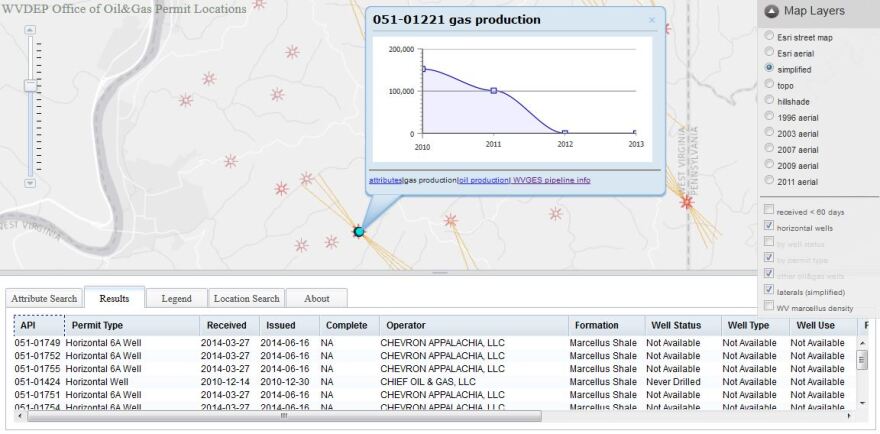The latest figures from the Department of Environmental Protection indicate that there are upwards of 400 horizontal well pads in West Virginia. Sounds pretty straight-forward. What does that mean? How many more will there be?
“It’s a public-accessible map that’s been in existence for at least 10 or 15 years,” said an environmental resource analyst in the Department of Environmental Protection’s Office of Oil and Gas, John Kearney.
Some of the latest figures for West Virginia:
- Horizontal well pads: ~400
- Horizontal wells issued to date: 3,757
- Horizontal wells completed: 1,664
- Horizontal wells permits cancelled (by the applicant, will never be drilled): 842
- ~200 applications currently pending
- DEP receives ~55 applications per month (fairly consistently over the last several years)
- Application takes between 60-90 days to be approved
What you can tell from the map:
- Location of each projected and finished well
- Company affiliated with well
- When application was received
- Rock formation the well drills into
- How much oil or gas is being produced, over how long
- Direction and lengths of the underground bores
“If there’s no production data with it, that means [operators] haven’t reported production on it yet.” Kearney explained.
Reasons there may bot be any information:
- Permit not issued yet.
- Well not drilled yet.
- Well could be drilled but not yet “completed” or fracked.
- Pipeline to well not yet installed.
- Well may be producing but the annual reporting date has not arrived. (Deadline for reporting 2014 production data is March 31st, 2015.)
Kearney said while some states like Ohio require quarterly reports, regulations in West Virginia only require companies to report annually.
What the map doesn’t show:
You can’t tell when a well will begin production. You can’t see any of the ancillary facilities associated with the horizontal wells which currently include 166 compressor stations, and 17 natural gas processing plants (sometimes called extraction facilities). You also can’t see the pipeline infrastructure that exists, or the water and tank management system that supports operation.
DEP officials explained that oils and gasses pass through many companies who manage the product from when it comes out of the ground to when it arrives, processed, to consumers, whether those consumers be residents, a Cracker Plant, a or power plant, in this country or abroad.
Looking forward, it’s hard to say how many more horizontal wells West Virginia will see. Just for some perspective: check out Pennsylvania, which has seen significantly more natural gas development.
***Note from editor: In an earlier version of this story we reported that there are about “400 horizontal wells” when we should have said “400 horizontal well pads.” The actual number of wells reporting production in 2013 (based on the most recent data) is 1,383. This story has been modified to reflect those numbers.























